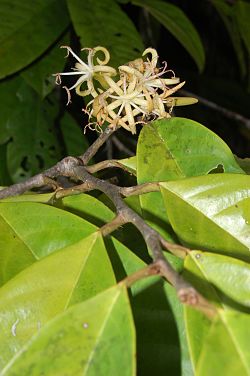メッテニウサ科
メッテニウサ科(メッテニウサか、Metteniusaceae)は、被子植物のメッテニウサ目に属する唯一の科である[1]。 主に熱帯地域に自生する11属約60種から構成される[2]。従来、本科はメッテニウサ属のみが属していたが、分子系統学の研究の成果から当時のクロタキカズラ科の内の10属が本科に属すことが分かり、整理された。
| メッテニウサ科 | ||||||||||||||||||||||||
|---|---|---|---|---|---|---|---|---|---|---|---|---|---|---|---|---|---|---|---|---|---|---|---|---|

| ||||||||||||||||||||||||
| 分類(APG IV) | ||||||||||||||||||||||||
| ||||||||||||||||||||||||
| 属 | ||||||||||||||||||||||||
|
本文参照 |

概要
編集主に熱帯地方に自生して、樹木や低木といった木本植物として分布している。樹高はDendrobangia boliviana で最大40m、Poraqueiba sericea で最大30mになる。葉は互生で葉柄は堅い。数種の葉は乾燥すると黒くなる。花序は楕円形または斜めに様々で、束生、腋生集散花序、穂状花序、円錐花序などがある。花は両性で時に単性。雄しべは5本または4本で、しばしば短くて平らな花糸がある。雌しべは5心皮合生(Calatola属は4心皮)で、子房は1または2-3つの子房室から成り、糸状または太い花柱がある。果実は核果、1種子をつける[3][4][5][6][7][8][9]。
-
Emmotum nitens の果実がついた枝
-
Emmotum nitens の花序
分布
編集メッテニウサ科には11属64種があるとされる。分布はラテンアメリカ、サハラ以南のアフリカ、マダガスカル、アジアの熱帯地域、オーストラリア、ニューカレドニアと広い。特に熱帯アメリカ(メキシコ、中南米、カリブ海)で最も多様性が高く、7属37種が見られる。アジアの熱帯地域には3属(Platea 属、Pittosporopsis 属、Apodytes 属)があり、インド及び中国南部から東南アジアに至る。クイーンズランド州の固有種である Apodytes brachystylis は、オーストラリアで唯一の種である。ニューカレドニアにも、Apodytes clusiifolia という固有種が分布する。サハラ以南のアフリカとマダガスカルには、Rhaphiostylis 属とApodytes 属の2属が生息する。最も広い分布域を持つ種は、唯一アフリカとアジアの両大陸に分布する Apodytes dimidiata である[10]。
分類
編集本科は元来メッテニウサ属7種だけを含み、従来のAPG体系においてもその枠組みが踏襲されてきたが、2016年のAPG IVでは、クロタキカズラ目のクロタキカズラ科に属すと考えられてきた以下の10属がメッテニウサ目メッテニウサ科に移された[11][12]。
- Apodytes - 6種
- Calatola - 7種
- Dendrobangia - 3種
- Emmotum - 10種
- Oecopetalum - 3種
- Ottoschulzia - 3種
- Pittosporopsis - 1種
- Platea - 5種
- Poraqueiba - 3種
- Rhaphiostylis - 10種
系統
編集キク類
| ||||||||||||||||||||||||||||||||||||||||||||||
利用
編集Metteniusa edulis の種子は、コロンビア北部および東部の原住民の食糧となっている[13]。他に南米の Poraqueiba sericea とアジアの Pittosporopsis kerrii の種子も食用とされる。アフリカからアジアにかけて広く分布する Apodytes dimidiata は、材の硬さから建築資材として利用されるだけでなく、アフリカ先住民には薬としても重宝されている[6][14][3]。
参考文献
編集- ^ Angiosperm Phylogeny Group (2016). “An update of the Angiosperm Phylogeny Group classification for the orders and families of flowering plants: APG IV”. Botanical Journal of the Linnean Society 181 (1): 1–20. doi:10.1111/boj.12385.
- ^ Christenhusz, M. J. M.; Byng, J. W. (2016). “The number of known plants species in the world and its annual increase”. Phytotaxa (Magnolia Press) 261 (3): 201–217. doi:10.11646/phytotaxa.261.3.1.
- ^ a b Berry, P.E. et al. (1999), Flora of the Venezuelan Guayana (vol. V), Missouri: Timber Press, ISBN 0-915279-71-1
- ^ Leistner, O.A (2005), Seed plants of southern tropical Africa: families and genera, Pretoria: SABONET, ISBN 1-919976-07-8
- ^ Steenis, C. (ed.) (1971), Flora Malesiana. Vol. 7 (1), Leiden, Niederlands: Foundation Flora Malesiana
- ^ a b Peng, Hua; Howard, Richard A., Flora of China: Pittosporopsis
- ^ Peng, Hua; Howard, Richard A., Flora of China: Platea
- ^ Standley, Paul C.; Steyermark, Julian A. (1949/12), Flora of Guatemala. Icacinaceae, 24(6), Fieldiana
- ^ Báez, Celso Gutiérrez (2008/01), La familia Icacinaceae en la Península de Yucatán, México, 25, Polibotánica
- ^ Hassler, M. (2016), Catalogue of life. Synonymic Checklists of the Vascular Plants of the World, Naturalis Biodiversity Center
- ^ Byng, James W. et al. (2016), An update of the Angiosperm Phylogeny Group classification for the orders and families of flowering plants: APG IV, 181, Botanical Journal of the Linnean Society
- ^ Stull, Gregory W. et al., Resolving basal lamiid phylogeny and the circumscription of Icacinaceae with a plastome-scaledat a set, 102(11), American Journal of Botany
- ^ González, Favio A.; Rudall, Paula J. (2010), Flower and fruit characters in the early-divergent lamiid family Metteniusaceae, with particular reference to the evolution of pseudomonomery, 97(2), American Journal of Botany
- ^ PlantZAfrica.com: Apodytes dimidiata, South African National Biodiversity Institute, (2000)